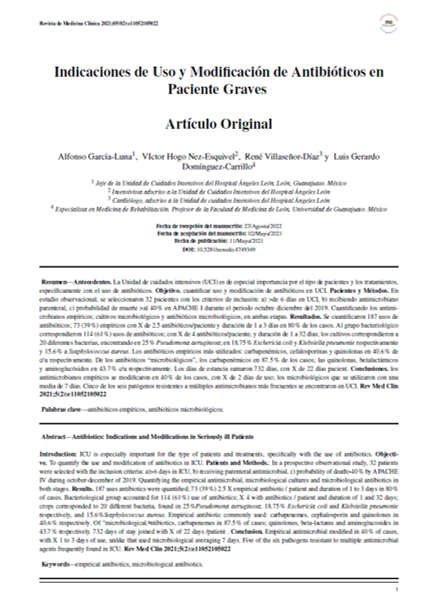Abstract
Background. ICU is especially important for the type of patients and treatments, specifically with the use of antibiotics. Objective. To quantify the use and modification of antibiotics in ICU. Patients and Methods. In a prospective observational study, 32 patients were selected with the inclusion criteria: a)> 6 days in ICU, b) receiving parenteral antimicrobial, c) probability of death> 40% by APACHE IV. Quantifying the empirical antimicrobial, microbiological cultures and microbiological antibiotics in both stages. Results. 187 uses antibiotics were quantified; 73 (39%) 2.5 X empirical antibiotic / patient and duration of 1 to 3 days in 80% of cases. Bacteriological group accounted for 114 (61%) use of antibiotics; X 4 with antibiotics / patient and duration of 1 and 32 days; crops corresponded to 20 different bacteria, found in 25% Pseudomonas aeruginosa; 18.75% Escherichia coli and Klebsiella pneumoniae respectively, and 15.6% Staphylococcus aureus. Empirical antibiotic commonly used: carbapenemes, cephalosporin and quinolones in 40.6% respectively. Of "microbiological" antibiotics, carbapenemes in 87.5% of cases; quinolones, beta-lactams and aminoglucosides in 43.7% respectively. 732 days of stay joined with X of 22 days /patient Conclusions. empirical antimicrobial modified in 40% of cases, with X 1 to 3 days of use, unlike that used microbiological averaging 7 days. Five of the six pathogens resistant to multiple antimicrobial agents frequently found in ICU.
References
Luyt CH, Bréchot N, Trouillet JL Chastre J. Antibiotic stewardship in the intensive care unit. Critical Care 2014, 18:480- 492. doi.org/10.1186/s13054-014-0480-6
Laxminarayan R, Duse A, Wattal C, Zaidi AK, et al. Antibiotic resistance - the need for global solutions.Lancet Infect Dis 2013, 13:1057-1098. doi: 10.1016 / S1473-3099 (13) 70318-9.
Bloos F, Thomas-Ruddel D, Ruddel H, Engel C, et al. Impact of compliance with infection management guidelines on outcome in patients with severe sepsis: a prospective observational multi-center study. Crit Care 2014, 18:R42. doi: 10.1186 / cc13755.
Kollef MH. Providing appropriate antimicrobial therapy in the intensive care unit: surveillance vs de-escalation. Crit Care Med 2006;34:903-905. doi: 10.1097 / 01.CCM.0000202128.30405.60.
Silva BN, Andriolo RB, Atallah AN, Salomao R: De-escalation of antimicrobial treatment for adults with sepsis, severe sepsis or septic shock. Cochrane Database Syst Rev 2013;3:CD007934. doi: 10.1002/14651858.CD007934
Leuthner KD, Doern GV: Antimicrobial stewardship programs. J Clin Microbiol 2013, 51:3916-3920. doi: 10.1128 / JCM.01751-13
Yahav D, Leibovici L, Goldberg E, Bishara J, Paul M: Time to first antibiotic dose for patients hospitalised with community-acquired pneumonia. Int J Antimicrob Agents 2013, 41:410-413. doi.org/10.1016/j.ijantimicag.2013.01.008
Roberts JA, Abdul-Aziz MH, Lipman J, Mouton JW, Vinks AA, Felton TW, et al. Individualised antibiotic dosing for patients who are critically ill: challenges and potential solutions. Lancet Infect Dis 2014, 14:498-509. doi: 10.1016 / S1473-3099 (14) 70036-2.
Fry DE. Fever in the ICU. The ICU Book 2008; 39:716-719.
Gooch M, Cook PP: Impact of regular collaboration between infectious diseases and critical care practitioners on antimicrobial utilization and patient outcome. Crit Care Med 2013, 41:2099-2107. doi: 10.1097 / CCM.0b013e31828e9863.
Weiss CH, Moazed F, McEvoy CA, Singer BD, et al. Prompting physicians to address a daily checklist and process of care and clinical outcomes: a single-site study. Am J Respir Crit Care Med 2011, 184:680-686. doi: 10.1164 / rccm.201101-0037OC.
Hranjec T, Rosenberger LH, Swenson B, Metzger R, et al. Aggressive versus conservative initiation of antimicrobial treatment in critically ill surgical patients with suspected intensive-care-unit-acquired infection: a quasi-experimental, before and after observational cohort study. Lancet Infect Dis 2012, 12:774-780. doi: 10.1016 / S1473-3099 (12) 70151-2.
Cornely OA, Bassetti M, Calandra T, Garbino J, et al. Escmid* guideline for the diagnosis and management of candida diseases 2012: non-neutropenic adult patients. Clin Microbiol Infect 2012, 18:19-37. doi: 10.1111 / 1469-0691.12039.
Pena C, Suarez C, Ocampo-Sosa A, Murillas J, et al. Effect of adequate single-drug vs combination antimicrobial therapy on mortality in pseudomonas aeruginosa bloodstream infections: a post hoc analysis of a prospective cohort. Clin Infect Dis 2013, 57:208-216. doi.org/10.1093/cid/cit223
Luyt CE, Aubry A, Lu Q, Micaelo M, Brechot N, Brossier F, et al. Imipenem, meropenem, or doripenem to treat patients with pseudomonas aeruginosa ventilator-associated pneumonia. Antimicrob Agents Chemother 2014, 58:1372-1380. doi: 10.1128 / AAC.02109-13
Dimopoulos G, Poulakou G, Pneumatikos IA, Armaganidis A, Kollef MH, Matthaiou DK. Short- vs long-duration antibiotic regimens for ventilator-associated pneumonia: a systematic review and meta-analysis. Chest 2013, 144:1759-1767. doi: 10.1378 / cofre.13-0076.
Palmer LB, Smaldone GC: Reduction of bacterial resistance with inhaled antibiotics in the ICU. Am J Respir Crit Care Med 2014, 189:1225-1233. doi: 10.1164 / rccm.201312-2161OC.
Dellinger RP, Levy MM, Rhodes A, Annane D, et al. Surviving sepsis campaign: international guidelines for management of severe sepsis and septic shock. Crit Care Med 2013, 41:580-637. doi: 10.1097 / CCM.0b013e31827e83af.
Arnold HM, Hollands JM, Skrupky LP, Smith JR, Juang PH, Hampton NB, et al. Prolonged infusion antibiotics for suspected gram-negative infections in the ICU: a before-after study. Ann Pharmacother 2013, 47:170-180. doi: 10.1345 / aph.1R523.
Wacker C, Prkno A, Brunkhorst FM, Schlattmann P: Procalcitonin as a diagnostic marker for sepsis: a systematic review and meta-analysis. Lancet Infect Dis 2013, 13:426-435. doi: 10.1016 / S1473-3099 (12) 70323-7.
Cotta MO, Roberts JA, Tabah A, Lipman J, et al. Antimicrobial stewardship of beta-lactams in intensive care units. Expert Rev Anti Infect Ther 2014, 12:581-595. doi.org/10.1586/14787210.2014.902308
Teo J, Liew Y, Lee W, Kwa AL: Prolonged infusion versus intermittent boluses of beta-lactam antibiotics for treatment of acute infections: a meta-analysis. Int J Antimicrob Agents 2014, 43:403-411. doi: 10.1016 / j.ijantimicag.2014.01.027
Lodise TP, Drusano GL: Pharmacokinetics and pharmacodynamics: optimal antimicrobial therapy in the intensive care unit. Crit Care Clin 2011, 27:1-18. doi: 10.1016 / j.ccc.2010.11.003.
Udy AA, Baptista JP, Lim NL, Joynt GM, et al. Augmented renal clearance in the ICU: results of a multicenter observational study of renal function in critically ill patients with normal plasma creatinine concentrations. Crit Care Med 2014, 42:520-527. doi: 10.1097 / CCM.0000000000000029.

This work is licensed under a Creative Commons Attribution-NonCommercial-NoDerivatives 4.0 International License.
Copyright (c) 2021 Revista de Medicina Clínica

